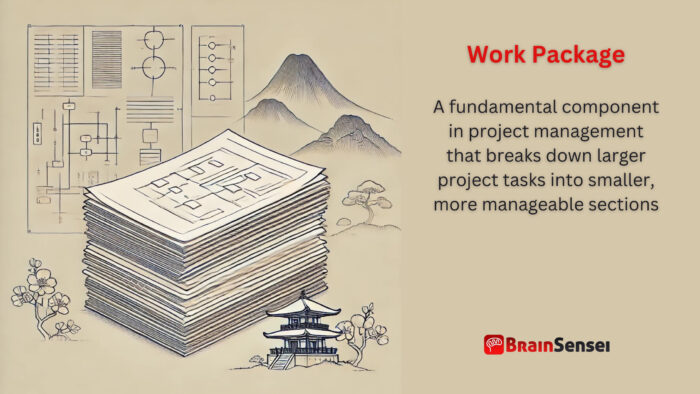
Work Package
What is a Work Package?
A work package is a fundamental component in project management that breaks down larger project tasks into smaller, more manageable sections. These packages are the building blocks of a work breakdown structure (WBS) and provide detailed information about specific deliverables, costs, schedules, and resources.
Key Takeaways
- Definition: A smaller, well-defined section of a larger project
- Part of WBS: Integral to the Work Breakdown Structure for efficient project planning
- Resource Allocation: Assigns tasks, resources, and responsibilities effectively
- Measurable Milestones: Helps track progress with clear deliverables and deadlines
- Scope Clarity: Reduces complexity and enhances focus on individual tasks
Understanding Work Packages
How It Works
Work packages are crucial in simplifying complex projects. By breaking down these projects into smaller, more manageable units, they make it easier to assign, manage, and monitor tasks. Each package contains detailed instructions about the work and estimates of time, cost, and resources, making the project more manageable and less overwhelming.
For example, in a construction project, a work package might detail the materials, tasks, labour hours, and budget required for laying a building’s foundation.
Notes
- Granularity Matters: Should be detailed enough for effective task management
- Ownership Assignment: Assign each package to a specific team or individual
- Regular Monitoring: Track and review package progress against the project timeline
- Dependency Identification: Identify dependencies between different packages
- Document Everything: Maintain comprehensive records for better transparency
Work Packages and Related Terms
- Work Breakdown Structure (WBS): A hierarchical framework organizes project tasks into work packages
- Deliverables: Tangible outputs defined within a work package
- Milestone: Key points that indicate progress
- Scope Statement: Document defining the boundaries and requirements
- Project Charter: High-level document outlining project objectives
Examples of Work Packages
Manufacturing Industry
A work package might include the design and assembly of the engine in a car manufacturing project. This package would specify tasks such as component sourcing, assembly processes, quality checks, labour allocation, and timelines. The design team would begin by selecting materials based on durability, cost, and performance requirements. Next, they break down the assembly process into smaller tasks like component manufacturing, quality assurance, and logistics. The project manager would monitor milestones throughout the process to ensure timely completion.
Additionally, a work package for the car’s interior might include tasks such as seat design, dashboard installation, and electronic system integration. Each task would have associated costs, required resources, and deadlines. By structuring the project into these packages, the manufacturing company ensures that teams work efficiently without overlap or confusion.
Healthcare Industry
A hospital expansion project might include a work package for installing MRI equipment. The package would outline electrical installations, equipment procurement, space preparation, and staff training. The process would start with planning the MRI suite layout and coordinating with vendors for equipment delivery. Next, the electrical team would install specialized wiring to handle the MRI’s power needs while the facilities team prepared the room to meet safety and operational standards.
The work includes staff training and technical tasks. The project team scheduled training sessions to develop radiologists’ and technicians’ competencies in the competencies of radiologists and techniques. The team maintains the documentation throughout the process to track progress and address issues.
Telecommunications Industry
A network infrastructure project could have a work package focused on fibre-optic cable installation, detailing equipment needs, route planning, regulatory compliance, and workforce schedules. The project might begin with a site survey to determine optimal cable routes and procuring cables and related equipment. Installation teams follow a step-by-step plan to lay the cables, test connections, and configure network settings.
The work would address external factors like obtaining permits from local authorities and adhering to industry regulations. The project manager would use progress reports to monitor installation stages and ensure the infrastructure meets performance requirements and deadlines. The telecommunications company can optimize resource allocation and maintain high-quality standards by compartmentalizing tasks into work packages.
These examples illustrate the versatility of work packages across different industries, highlighting their role in simplifying complex projects and ensuring systematic, efficient execution.
Use Cases of Work Packages
United States (Construction Project)
In the U.S., a commercial building project used work packages to streamline tasks like foundation work, HVAC installation, and electrical systems. Each package helped assign responsibilities to different subcontractors, ensuring seamless integration. The project team first created a comprehensive Work Breakdown Structure (WBS) to identify the building’s significant components, such as the structural framework, electrical systems, plumbing, and interior finishes. The team lead breaks down each significant component into tasks, materials, timelines, and responsible parties.
For instance, the HVAC installation included tasks like sourcing ductwork, installing climate control systems, and testing airflow. The project manager monitored progress through weekly meetings and updated the schedule as necessary to address unforeseen delays, such as supplier issues. Effective communication between subcontractors ensured proper management of the dependencies between work packages, such as the need for completed ductwork before installing ceilings. This systematic approach helped the project finish on time and within budget.
Germany (IT Software Development)
A German software firm employed work packages to manage the development of an enterprise application. The team divided the project into modules for database development, front-end design, and testing. They treated each module as a work package with specific deliverables and milestones. The database development work package included schema design, data migration, and query optimization tasks.
The front-end design work package detailed tasks related to user interface design, usability testing, and integration with backend services. The testing work package specified unit testing, integration testing, and performance testing requirements. The project manager used Agile methodologies to track progress, holding daily stand-up meetings to review completed tasks and address blockers. Regular reviews with stakeholders ensured that the software met business requirements and user expectations.
India (Renewable Energy)
In India, a solar power installation project utilized work packages to handle tasks like panel procurement, site preparation, and system integration. The manager initiated the project with a feasibility study to identify potential locations, solar panel specifications, and regulatory requirements. They learned that the site preparation involved clearing land, constructing support structures, and laying electrical conduits.
The procurement work package focused on sourcing photovoltaic panels, inverters, and batteries from approved vendors. The installation work package covered tasks like mounting panels, connecting wiring, and configuring the power management system. The project manager coordinated with suppliers and contractors to synchronize deliveries and installation tasks, ensuring minimal downtime. Periodic performance tests validated system efficiency, while regular team meetings addressed challenges and facilitated knowledge sharing.
By breaking down the project into clearly defined work packages, the solar power company achieved its goal of delivering a reliable and efficient energy solution on schedule and within budget.
Best Practices for Work Packages Implementation
Effectively implementing work packages requires a strategic and methodical approach. Below are best practices to ensure successful integration:
Define Scope Clearly
Ambiguity can lead to confusion and inefficiency. Clearly define the scope of work by specifying tasks, deliverables, deadlines, and success criteria. Collaborate with stakeholders to align expectations and document all decisions to maintain consistency.
Assign Responsibilities
Each work package should have a designated owner. Assign responsibilities based on team members’ expertise and workload to enhance accountability. Clearly communicate roles and ensure that team members understand their responsibilities and expectations.
Use Tracking Tools
Project management tools like MS Project, Primavera, or Jira can streamline work package management. These tools offer features for task assignment, progress tracking, and performance analysis, ensuring better control over timelines and resources.
Communicate Regularly
Communication gaps can derail a project’s success. Schedule regular meetings, create clear communication channels, and encourage open dialogue among team members. Utilize tools like Slack or Microsoft Teams to facilitate real-time information sharing.
Conduct Periodic Reviews
Regularly review the status of each work package to identify potential risks or delays. Use Key Performance Indicators (KPIs) to measure progress and address issues proactively. Document review findings to track lessons learned for future projects.
Focus on Quality Assurance
Include quality checks at various stages within the work package. Define quality standards at the outset and implement testing protocols to validate deliverables. Regular quality reviews help ensure that outcomes meet client and project requirements.
Risk Management
Identify potential risks early and develop mitigation strategies. Use tools like risk registers to track potential issues, assess their impact, and outline contingency plans. Involve the team in risk identification sessions to gain diverse perspectives.
Optimize Resource Allocation
Analyze resource needs and allocate personnel, equipment, and materials accordingly. Track resource utilization to avoid overloading or underutilizing resources, ensuring balanced workload distribution.
Documentation and Knowledge Sharing
Maintain detailed documentation of processes, decisions, and outcomes for each work package. This practice supports transparency and facilitates knowledge transfer to future project teams.
Continuous Improvement
Promote a culture of continuous improvement by encouraging feedback and analyzing project outcomes. Use lessons learned to refine future work package practices and enhance overall project efficiency.
Common Mistakes and Issues
Creating work packages without clear guidelines often leads to project setbacks. One common mistake is defining packages too broadly, resulting in confusion about task ownership and deliverables. For instance, a construction company divided its tasks into broad categories like ‘plumbing’ and ‘electrical work’ without specifying activities like pipe installation or wiring layout. This lack of detail caused delays and rework.
Another issue is underestimating the resources required for each package. A software development project once failed to allocate sufficient time for integration testing, leading to system malfunctions post-launch. Proper estimation methods like PERT or historical data analysis can mitigate such risks.
Miscommunication is another frequent issue. If teams lack access to updated package documentation, they may work with outdated requirements, causing inconsistencies. Using centralized project management tools helps maintain information accuracy.
Lastly, neglecting interdependencies between packages can derail timelines. In a manufacturing project, delayed component delivery postponed subsequent assembly tasks. Regular dependency reviews can prevent such bottlenecks.
Frequently Asked Questions (FAQs)
What is the purpose of a work package?
It breaks down larger tasks into smaller, manageable sections to improve planning, execution, and monitoring.
How detailed should a work package be?
They should provide enough detail to guide the responsible team or individual without ambiguity.
Who creates work packages?
Project managers and their teams typically create them during project planning.
How do work packages relate to WBS?
They form the lowest level of a Work Breakdown Structure, defining the specific tasks needed to complete project deliverables.
Can a work package change during a project?
Yes, it can be updated as project requirements evolve.
Additional Resources
Preparing for a PMI certification?
- Exam Prep Courses: PMP®, CAPM®, and PMI-ACP®
- Exam Simulators: PMP®, CAPM®, PMI-ACP®, PMI-PBA®, PMI-RMP®, PMI-SP®, PgMP®, and PfMP®
- Professional Development Units (PDUs): 15, 30, and 60 PDU Bundles



